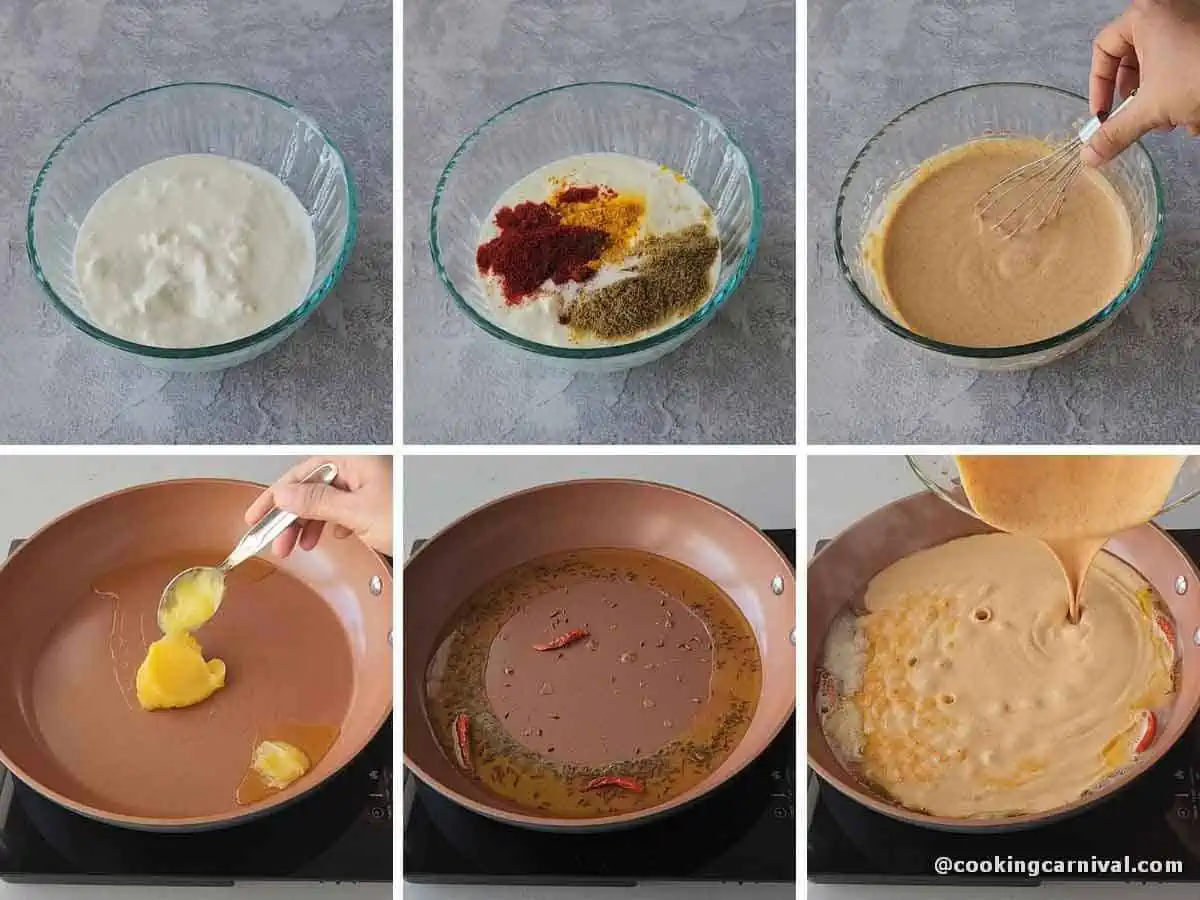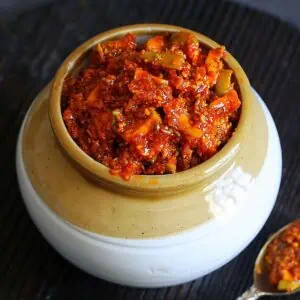Pitod Ki Sabji is a well-known and beloved Rajasthan curry that is quick and easy to make. This protein-rich sabji doesn’t require any vegetables and is made of gram flour dumplings in a curd-based gravy. Spicy and tangy, it pairs well with roti, paratha, and plain rice.
It’s almost similar to the Gujarati dish Dhokli nu Shaak, also made using Besan. This recipe is also perfect for Jain tithi days or during Paryushan parv.

Jump to:
While Gatte ki sabzi, dal baati, and churma are famous among Rajasthani recipes, Pitod Ki Sabzi is a hidden treasure that tastes amazing and is traditionally made in Rajasthani households.
What is Pitod ki Sabji?
It’s a soft, melt-in-mouth dumpling of gram flour cooked in a light, tangy yogurt-based Gravy. This Sabji is a specialty of Rajasthan and doesn’t contain onions or garlic.
It’s light, quick to make, and the perfect addition to your meal when you don’t have any vegetables in your fridge but still want to serve something fancy.
While Pitor ki Sabzi is easy to cook, it requires a little technique to get the perfect pitor.
We love serving this Rajasthani dish with rice, roti, or paratha.
Ingredients required
Below is the ingredients list and possible substitutions. The exact ingredient amounts are in the printable recipe card at the bottom of this post.
- Besan (Gram flour): Make sure you use fresh besan. Also, it is essential to sieve the flour before making the pitod.
- Yogurt (dahi): You will need slightly sour yogurt/curd.
- Spices: For Gravy, we will need fundamental spices like salt, red chili powder, cumin powder, coriander powder, garam masala, and turmeric powder. And for Pitod, we used salt, chili powder, hing, and turmeric powder.
- Whole spices: Red dried chilies, Cumin seeds, and carom seeds are also used in the Gravy and pitod.
- Clarified butter/ghee: It gives richness and texture to the Gravy. You can use oil instead of ghee, but to get the most authentic taste, I recommend you use ghee.

Step-by-step process
Step 1. Make Pitod
- In a big mixing bowl, sieve the besan. After that, add salt, chili powder, turmeric powder, hing, cumin powder, and carom seeds to the besan. Mix everything well.
- Now, slowly add water in batches, whisk, and make a lump-free, watery consistency batter. The batter has to be thin. Please maintain the water-flour ratio. Keep the batter aside.

- Heat a wide pan on medium to low heat. Pour the besan batter into the pan and stir.
- Cook on low to medium flame, stirring continuously. Cook until the mixture thickens and starts to separate the pan. This will take around 5 to 6 minutes.
- When the mixture thickens and comes together, switch off the stove. Immediately transfer the mixture to a big plate and spread the mixture evenly into ½ inch layer.
- Note: Make sure you use a big plate and spread the mixture into ½ inch layer. If you don’t have big plate, use two small plates to spread the mixture evenly.
- Allow it to cool completely. Now cut into pieces of the shape of your choice. I have cut it into a diamond shape. Keep aside.
- Tip – Some bits of pitod might be stuck to the pan where you cooked the pitod. You can use a spatula, spoon, or clean hands to scrape out any remaining bits from the bottom and sides of the pan. After scraping, add a cup of water to the scrapings and stir well. This mixture will be added to the Gravy, enhancing its taste and texture and helping to thicken it. Remember to keep this mixture aside until ready to use.

Step – 2 Make curry
- Take curd in a big bowl. Add cumin-coriander powder, chili powder, turmeric powder, salt, and garam masala. Mix everything very well.
- Now heat ghee in a wide pan. Add red red dried chilies, cumin seeds and let it splutter.
- Tip – I am making this for paryushan (Jain festival), so I haven’t used ginger, garlic, onions, and green chilies. You can add finely chopped ginger, garlic, onion, and green chilies if you are not making for paryushan.
- Add the prepared curd mixture and cook on low flame, stirring continuously until the ghee separates from the pan.

- Note: After adding curd, please stir continuously; otherwise, the curd will curdle.
- Then add the scraping-water mixture we kept aside earlier, stir well, and cook for 2 to 3 minutes.
- Then add prepared besan katli (Pitod) and mix gently. Simmer for 5 minutes or until the flavors are well absorbed and the Gravy thickens slightly. Adjust the seasoning and consistency according to your preference.
- Switch off the flame. Pitod Ri Sabji is ready.
- Serve it with Roti, Rice, or plain Paratha. Enjoy!.

Notes and pro-tips
- Use a large pot with a high rim to reduce splatter when cooking.
- Handle gram flour dumplings carefully, as they can fall apart quickly.
- You can replace regular yogurt/curd with Greek yogurt.
- If you don’t like spicy food, feel free to reduce the amount of chili powder.
- Keep stirring continuously after adding the curd mixture till it starts to boil; otherwise, the curd will curdle.
- Make sure your curd is not too sour.
- Due to the use of besan, the consistency of the curry may thicken once it is rested. Therefore, you may have to add water before it is served.
- If you have leftover Pitod Ki Sabji, you can store them in the fridge in an airtight container for 3-4 days. Microwave it for a few minutes or reheat it on a stovetop.
- I do not suggest freezing leftovers, as the delicate chickpea dumplings often fall apart when thawed.

More No onion no garlic Sabji recipes
Have you tried this Recipe? Please feed us with your feedback, ★ star ratings, and comments below.
You can also FOLLOW me on FACEBOOK, INSTAGRAM, and PINTEREST for more fabulous recipes and updates.
Subscribe to our YouTube Channel for tasty and easy video recipes.
Pitod Ki Sabji
Ingredients
For Pitod
- 1 cup Besan gram flour
- 1 teaspoon cumin seeds
- ½ teaspoon carom seeds Ajwain
- ¼ teaspoon hing
- 1 teaspoon chili powder
- ¼ teaspoon turmeric powder
- 1 teaspoon salt or to taste
- 2 ¼ cup water
For gravy
- 2 cup curd/plain yogurt
- 2 teaspoon red chili powder
- 2 teaspoon coriander powder
- 1 teaspoon cumin powder
- 1 teaspoon garam masala
- ½ teaspoon turmeric powder
- 1 teaspoon cumin seeds
- 3 red dried chilies
- 1 teaspoon salt or to taste
- 3 tablespoon ghee
- 1 cup water
Instructions
Step 1. Make Pitod
- In a big mixing bowl, sieve the besan. After that, add salt, chili powder, turmeric powder, hing, cumin powder, and carom seeds to the besan. Mix everything well.
- Now, slowly add water in batches, whisk, and make a lump-free, watery consistency batter. The batter has to be thin. Please maintain the water-flour ratio. Keep the batter aside.
- Heat a wide pan on medium to low heat. Pour the besan batter into the pan and stir.
- Cook on low to medium flame, stirring continuously. Cook until the mixture thickens and starts to separate the pan. This will take around 5 to 6 minutes.
- When the mixture thickens and comes together, switch off the stove. Immediately transfer the mixture to a big plate and spread the mixture evenly into ½ inch layer.
- Note: Make sure you use a big plate and spread the mixture into ½ inch layer. If you don’t have big plate, use two small plates to spread the mixture evenly.
- Allow it to cool completely. Now cut into pieces of the shape of your choice. I have cut it into a diamond shape. Keep aside.
- Tip – Some bits of pitod might be stuck to the pan where you cooked the pitod. You can use a spatula, spoon, or clean hands to scrape out any remaining bits from the bottom and sides of the pan. After scraping, add a cup of water to the scrapings and stir well. This mixture will be added to the Gravy, enhancing its taste and texture and helping to thicken it. Remember to keep this mixture aside until ready to use.
Step – 2 Make curry
- Take curd in a big bowl. Add cumin-coriander powder, chili powder, turmeric powder, salt, and garam masala. Mix everything very well.
- Now heat ghee in a wide pan. Add cumin seeds and let it splutter.
- Tip – I am making this for paryushan (Jain festival), so I haven’t used ginger, garlic, onions, and green chilies. You can add finely chopped ginger, garlic, onion, and green chilies if you are not making for paryushan.
- Add the prepared curd mixture and cook on low flame, stirring continuously until the ghee separates from the pan.
- Note: After adding curd, please stir continuously; otherwise, the curd will curdle.
- Then add the scraping-water mixture we kept aside earlier, stir well, and cook for 2 to 3 minutes.
- Then add prepared besan katli (Pitod) and mix gently. Simmer for 5 minutes or until the flavors are well absorbed and the Gravy thickens slightly. Adjust the seasoning and consistency according to your preference.
- Switch off the flame. Pitod Ri Sabji is ready.
- Serve it with Roti, Rice, or plain Paratha. Enjoy!.
Video
Notes
- Use a large pot with a high rim to reduce splatter when cooking.
- Handle gram flour dumplings carefully, as they can fall apart quickly.
- You can replace regular yogurt/curd with Greek yogurt.
- If you don’t like spicy food, feel free to reduce the amount of chili powder.
- Keep stirring continuously after adding the curd mixture till it starts to boil; otherwise, the curd will curdle.
- Make sure your curd is not too sour.
- Due to the use of besan, the consistency of the curry may thicken once it is rested. Therefore, you may have to add water before it is served.
- If you have leftover Pitod Ki Sabji, you can store them in the fridge in an airtight container for 3-4 days. Microwave it for a few minutes or reheat it on a stovetop.
- I do not suggest freezing leftovers, as the delicate chickpea dumplings often fall apart when thawed.
Nutrition
Warm Regards,
Dhwani.








Leave a Reply